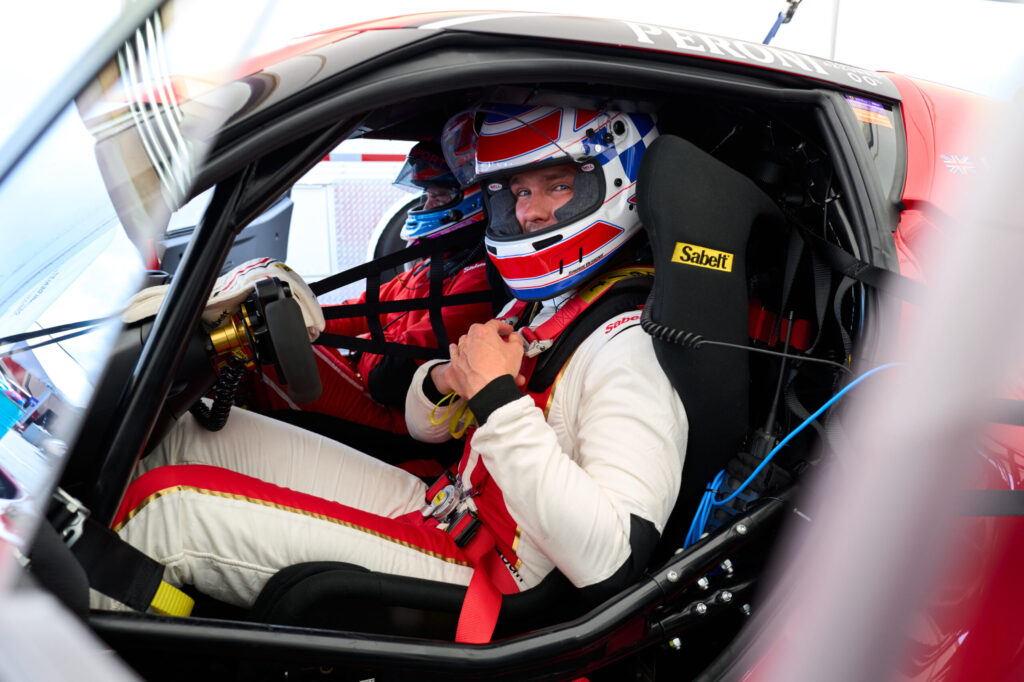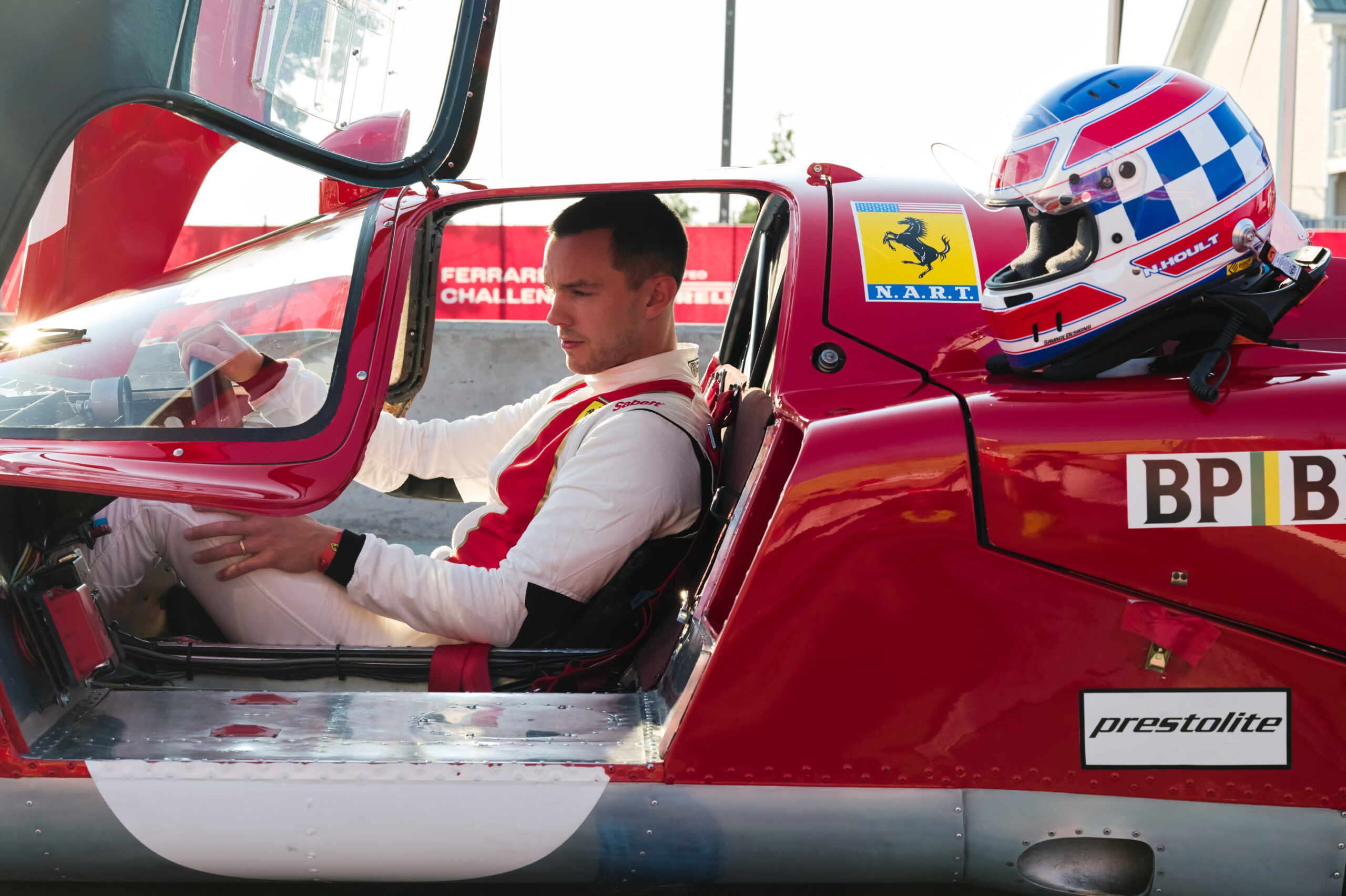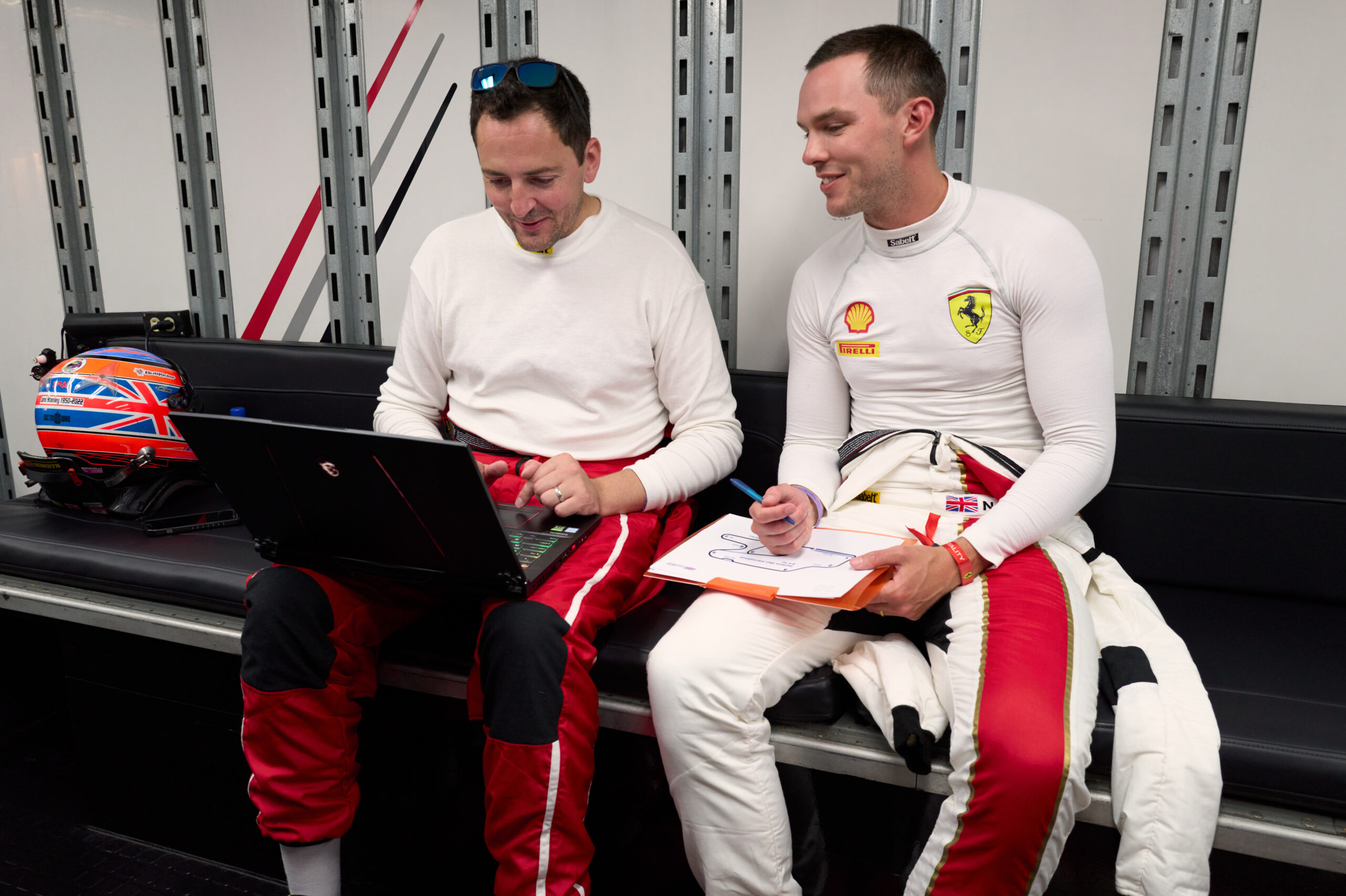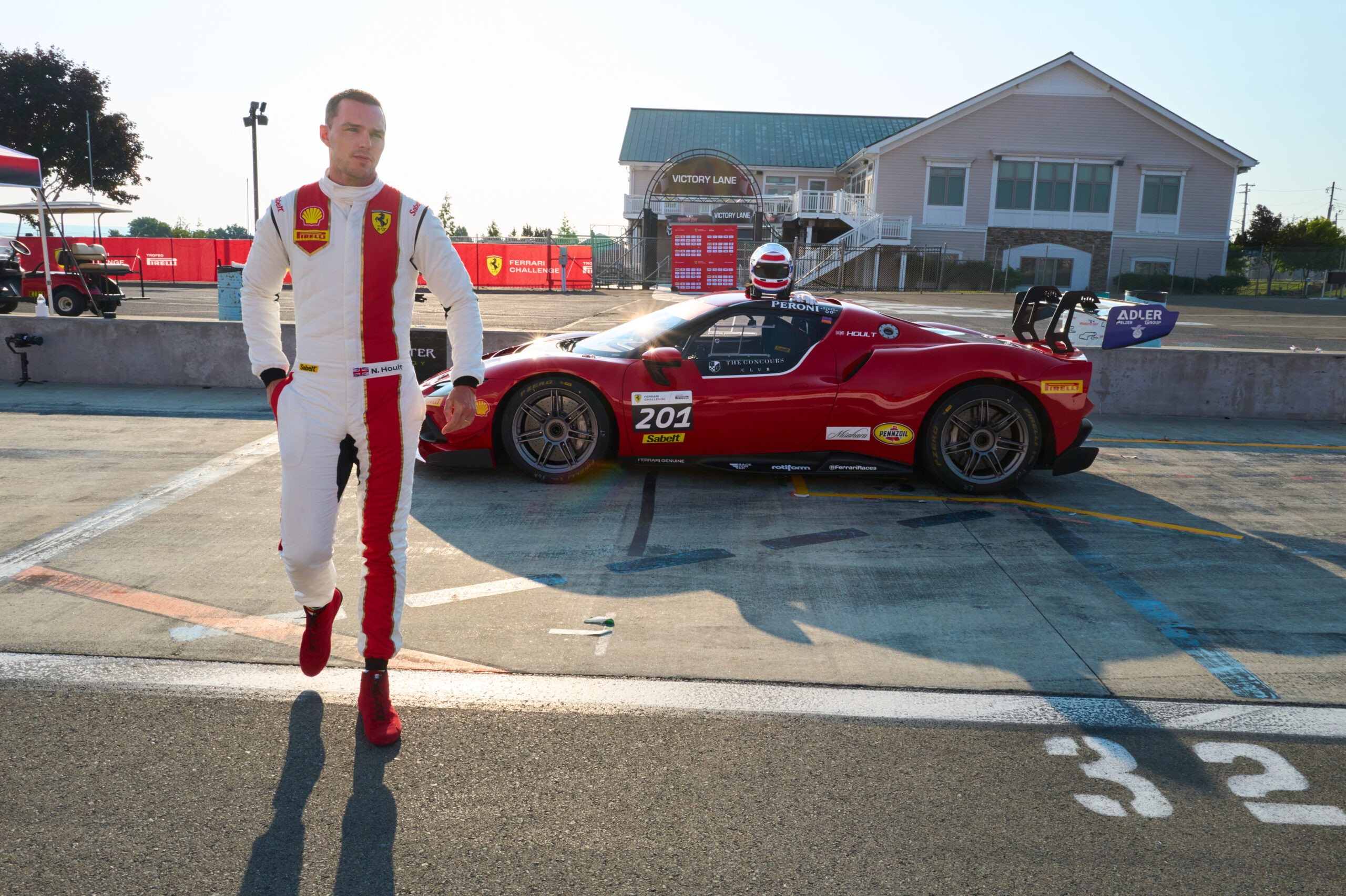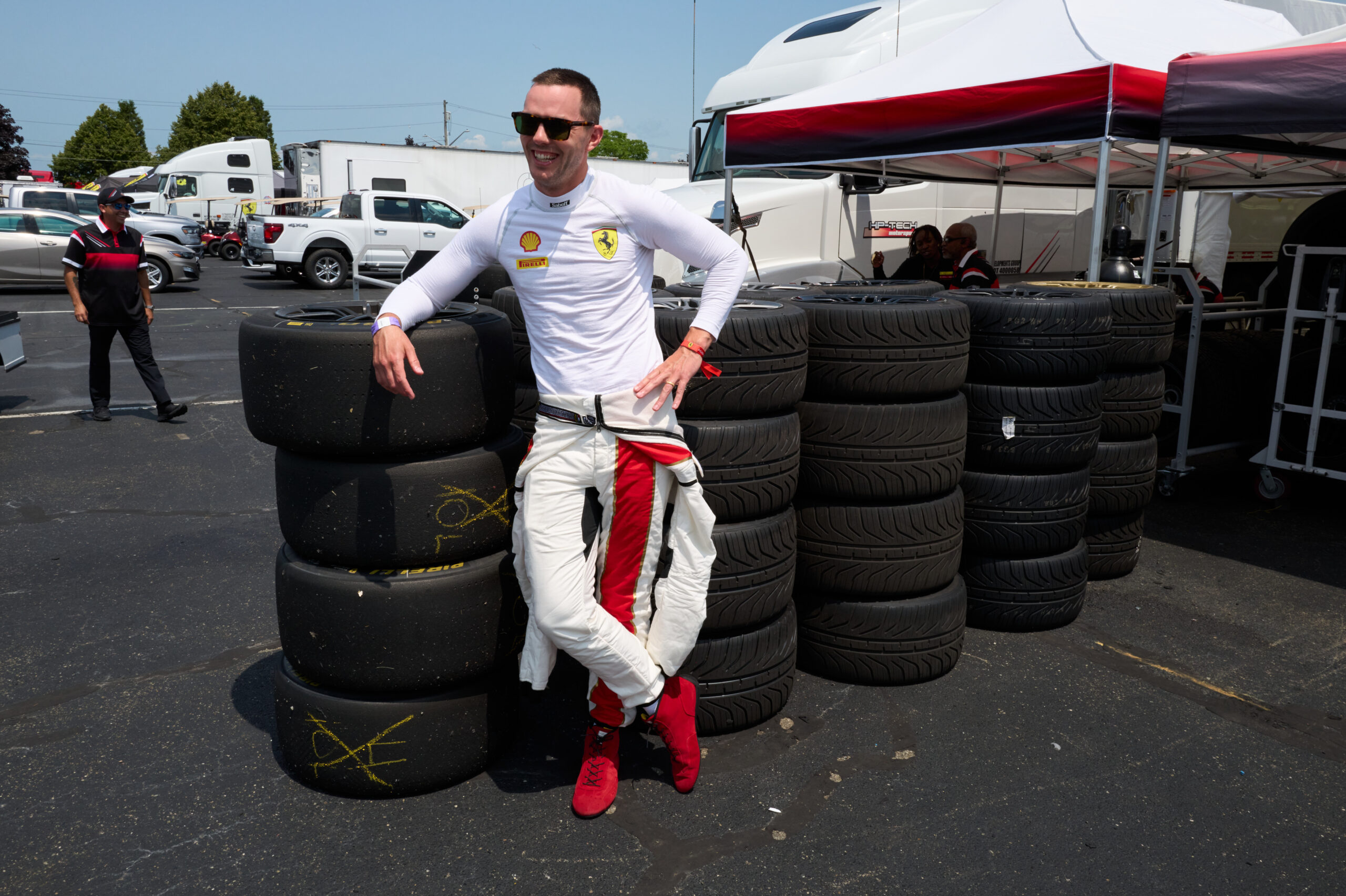You know the Emmy and Golden Globe-nominated Nicholas Hoult from any number of movies and TV shows: 2002’s About a Boy, the X-Men franchise, the Oscar-winning The Favourite, or Mad Max: Fury Road, in which his character Nux, the tattooed and maniacal gearhead, can be seen riding dirt bikes through a post-apocalyptic wasteland. And though virtually nothing about Nux resembles the actor who portrays him, it turns out they share one thing in common: a serious predilection for racing. Hoult, who’s set to appear in Nosferatu later this year before a presumably chilling turn as Lex Luthor in 2025’s Superman, has spent the last several years earning his racing stripes with Team Ferrari, having enrolled in and graduated from the carmaker’s Corso Pilati driving school. The culmination of his racing education came last weekend, when Hoult took part in—and won—the Ferrari Challenge in Watkins Glen, New York, a town whose road racing history stretches back to 1948, when it hosted the first-ever Watkins Glen Grand Prix. After the race, and a champagne celebration that went a little less smoothly, Hoult got on the phone with us talk about thrill-seeking, on both the track and the screen.
———
NICHOLAS HOULT: Hello?
JAKE NEVINS: Hey, Nicholas. How are you doing?
HOULT: Hey, I’m good. How are you doing?
NEVINS: I’m good.
HOULT: I’ll be off video because I’m at the beach. My boy’s at surf camp, so I’m keeping an eye on him whilst we chat.
NEVINS: I like your bucket hat.
HOULT: I get sunburned so easy. I’ve got to have that 360 brim.
NEVINS: The bucket hat is back in vogue.
HOULT: Oh, yeah?
NEVINS: For sure.
HOULT: Where are you talking from?
NEVINS: I’m at our offices downtown, right on Canal Street. It’s sweltering.
HOULT: New York summers are no joke.
NEVINS: It’s really intense. Speaking of New York, you raced last weekend in Watkins Glen. Is that upstate?
HOULT: Yeah. It was my first time going to Watkins. I guess there’s a rich history of racing there. It used to have a road race on the streets and the crosswalks are checkerboard, like a race flag. It’s a cool little town. It was my first time there and obviously I got to go to the track as well, which was a lot of fun. So it was a good weekend. They’ve got this national park there with this beautiful gorge and waterfalls. I don’t know if you have any interest in racing cars, but it’d be a good place to go for a weekend.
NEVINS: Well, it’s funny you should say that because I went to Miami for F1 a few months ago. I went into it with no real prior interest in racing. I’m a big sports fan, but F1 had not yet piqued my interest. Anyway, I left as a huge fan. I was pretty fascinated by the spectacle of it, how fast the cars go and how efficiently the pit crews worked. It was just pretty electric.
HOULT: Yeah, the atmosphere around an F1 race is pretty spectacular. What sports are you into normally?
NEVINS: I’ve been a competitive tennis player my whole life. I follow basketball and American football. Those three, pretty much. How about you?
HOULT: I grew up playing a bit of basketball. American football, I haven’t gotten into. I watch a lot of soccer and I follow a little bit of boxing.
NEVINS: Well, I would be remiss not to congratulate you on not only taking part in the race, but you fucking won…
HOULT: I managed to win the track attack, yeah, which was unexpected. I was very happy with that.
NEVINS: You’ve been doing this for a couple of years. Had you won a race before?
HOULT: I’ve placed, but no. To be honest with you, Watkins is a tricky track. Everyone kept on saying it’s intimidating and it takes a lot of guts because there’s quite a few moments on the track where you’re flat out, foot to the floor. There’s a section of the track called the S’s where you’re going uphill and you’re traveling 130, 140 miles an hour and you have to be quick, you have to keep your foot to the floor. But also there’s very little margin for error because there’s walls on either side of the track at that moment and you can’t exactly see where you’re going all the time. It’s intimidating, obviously—self-preservation kicks in and you’re like, “I don’t know if I should be doing this.” But you have to kind of override that and commit to it. I’ve been doing this with Ferrari for a couple of years now and started with the Corso Pilota program—they have great instructors and you gradually build up the pace, and hopefully your skill set as well, and get faster and faster. Now, in the Challenge car, it’s feeling like my skills are developing nicely, but also my confidence in understanding what the car needs input-wise to get the best out of it around the track. I mean, there’s just so many different elements that can make you slow and off the pace that it’s an interesting process to figure out.
NEVINS: It sounds fascinating. I’m curious how it compares to driving in Mad Max: Fury Road.
HOULT: How does it compare? I mean, on Fury Road, there were definitely moments where they’d give the signal to start the engines and I could feel the hairs on my arms stand up. There were just 30, 40, 50 vehicles all in a row and it’d be so incredibly loud. And that sort of high-intensity atmosphere, like you experienced at F1, is fun to be around. It gets your adrenaline pumping. The difference being, with Mad Max, a lot of the time you’d have a stunt driver who was doing the stuff for you hidden from camera and you’d be pretending and focusing on your dialogue. Whereas, when I’m doing this with Ferrari, there’s nowhere to hide because it’s you at the controls. If things go wrong, it’s your fault. And also, your coach will break down the telemetry and go into the minutiae and detail of your lap, what you’re doing, if you’re braking at the right time, or if you’re too soft on the brakes and not getting on the throttle. I don’t know how I’d describe the feeling before you go out on track. It’s an extreme state of focus and nerves. But in terms of the intensity of being in a race car and getting the signals to pull out of the pit, then you’re on your own and it’s like, “Okay, well, it can be a dangerous sport.” So it’s not to be taken lightly.
NEVINS: That adrenaline you mentioned, is it at all similar to the kind of rush you might feel before performing say, a big monologue, or the climax of a movie you’re filming?
HOULT: It’s interesting, because I guess I do compare being an actor to being an athlete in some regards because you get cast in something, you have the script, you have your prep time, and you prepare mentally and physically. They can be kind of equated in that, if you put too much pressure on yourself and try too hard in those moments, you can actually stifle your ability to deliver what you need. With filming, you have to be able to pivot if need be. That’s something I’ve been learning more and more recently. I’ll obviously have an idea of what the scene should be or what the moment should be for the character in my mind, but if that’s not working, then being able to adjust, try something new, is important. For instance, my second day on track at Watkins, I was a few seconds off the pace and I was trying to figure out what it was. There’s a section of the track called the Bus Stop and my coaches were like, “You’re not using enough of this fourth curve to get through, so you’re not carrying enough speed because you’re not taking the right line through here.” So they were like, “Hey, your first lap out there, just go out there and just get right over that curve.” So there’s lots of similarities in terms of being able to change things to make it work better for you, I suppose.
NEVINS: I see. Are there any drivers you look up to?
HOULT: Lewis [Hamilton] has definitely got to be one of them. I grew up watching F1 with my dad, so that was when Michael Schumacher was racing for F1, Mika Häkkinen and Damon Hill, that kind of era.
NEVINS: Do you watch Drive to Survive?
HOULT: I do, I do. It’s fun because that show has gotten a lot of people into F1. Even if people don’t watch the races, they love that show because they do a really good job of highlighting the relationships and dynamics that are exciting to see in a documentary format. So I enjoy that show. Actually, if you’re into sports and you enjoyed Miami, I’d recommend watching it. It’s pretty neat.
NEVINS: Well, I went to Miami totally in the dark. I was like, “How do I study up on this?” Luckily, there was a whole Netflix show waiting for me.
HOULT: It’s great because now people who don’t watch F1 all the time, they have that as a basis where you can have full-on conversations with them about it and they’ll have their favorite drivers and whatever else. I like what it’s doing for the sport.
NEVINS: Right. I wanted to ask, what are the conditions like inside that tiny little car? Is it cramped?
HOULT: Oh yes, it is. So the 296 GTB Ferrari is what the Challenge car is based on. It’s fully kitted out in terms of a roll bar and the aero race tires. It’s 700 horsepower, I think V6 twin turbo. There’s a particular technique to get in it. I’m six-foot-two, nearly six-three. So it’s like, to get in the car is a challenge, first of all. But then, once you get in, there’s a racing wheel with your pit limiter and you have a five-point harness where you’re really cinched down and strapped into the car. And then you have your HANS device, which is a head and neck saver. I might be butchering this, but I think it got put into racing in the ’80s and basically, it attaches to your helmet and then goes underneath the straps that go over your shoulders so that if you do crash, your head can’t go too far from your body. It’s saved a lot of lives and made racing a lot safer.
NEVINS: It sounds awfully constricting.
HOULT: You are really, really constricted. And it gets hot. One of the things that I struggle with is staying relaxed, because obviously your body, in those situations, its natural reaction is to kind of tense up. And that’s the worst thing you can do, because it slows down your reaction time and your input. The thing that I really love about racing is how, when it’s going well, it puts you in this meditative state where you have input, output, and you obviously have to be very present because of the situation you’re in. I think the top speed we were hitting at Watkins was 170 miles-per-hour.
NEVINS: Jesus Christ.
HOULT: [Laughs] So you’re moving and trying to stay calm and focused and obviously not make any mistakes, but also things are happening quickly and you have to slow them down in your brain. When you’re in the car, with all the noise, the rumbling, and the way the car feels, it’s one of the most intense environments I’ve ever been in.
NEVINS: Do you consider yourself a rather competitive guy?
HOULT: I do. And I’m competitive with myself as well. If I’m going to do something, I want to do it to the best of my ability. So this past weekend, as I said, by the end of day two I was a bit off the pace and I was struggling and I found that pretty frustrating, to be honest with you. At that moment, I couldn’t figure out exactly what I was doing wrong. So it was great to have the final day to go out there and have the track attack, but also have more time just to figure out what it was and improve. It’s not something that I can practice all the time, so I have to really focus and use the time as best as possible.
NEVINS: Right, you’ve got that old nine to five.
HOULT: They don’t like it if you’re racing on the side. The insurance doesn’t like that so much.
NEVINS: Oh, I’m sure.
HOULT: I want to get into tennis. That’s a sport that I’d like to start playing. I was just reading that thing about how tennis players often have much lower rates of dementia later on in life.
NEVINS: Is that right?
HOULT: Yeah, I think so. It’s something to do with the physicality of it, but also I guess how your brain processes the information and reaction speed and stuff in tennis.
NEVINS: That makes sense. It can be pretty cerebral. It sounds like racing is, too.
HOULT: Yeah, it is very cerebral. And like I said, that’s probably one of the things that most interests me about it, how it is very cerebral whilst being high-intensity and out-of-body, almost.
NEVINS: What’s the funniest intrusive thought that has crept in over the course of an hourlong race?
HOULT: This isn’t a funny or interesting one, but occasionally I’m like, “Should I be out here? Should I be doing this?” You really don’t want to have any intrusive thoughts, but that one’s obviously not ideal.
NEVINS: Well, the next time that happens, just remember you won.
HOULT: I know. It was the first time I got to go on a podium and spray champagne. I did a terrible job of it. I saw the photo and I was like, “I haven’t got my thumb over the bottleneck properly. I’m not spraying it.” It was an embarrassing attempt at a champagne celebration. But maybe I can get on some more podiums and get better at it.
NEVINS: I want that for you.
HOULT: Thank you for chatting. I hope to meet you in person at one point down the road. I’ve been talking about doing some tennis lessons.
NEVINS: You give me a driving lesson, I’ll give you a tennis lesson. How’s that sound?
HOULT: Honestly, I would love that.

